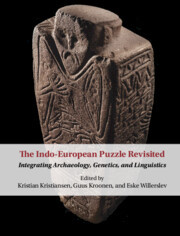
The Indo-European Puzzle Revisited
Integrating Archaeology, Genetics, and Linguistics
- Publisher's listprice GBP 100.00
-
47 775 Ft (45 500 Ft + 5% VAT)
The price is estimated because at the time of ordering we do not know what conversion rates will apply to HUF / product currency when the book arrives. In case HUF is weaker, the price increases slightly, in case HUF is stronger, the price goes lower slightly.
- Discount 10% (cc. 4 778 Ft off)
- Discounted price 42 998 Ft (40 950 Ft + 5% VAT)
Subcribe now and take benefit of a favourable price.
Subscribe
47 775 Ft

Availability
Estimated delivery time: In stock at the publisher, but not at Prospero's office. Delivery time approx. 3-5 weeks.
Not in stock at Prospero.
Why don't you give exact delivery time?
Delivery time is estimated on our previous experiences. We give estimations only, because we order from outside Hungary, and the delivery time mainly depends on how quickly the publisher supplies the book. Faster or slower deliveries both happen, but we do our best to supply as quickly as possible.
Product details:
- Publisher Cambridge University Press
- Date of Publication 11 May 2023
- ISBN 9781009261746
- Binding Hardback
- No. of pages358 pages
- Size 286x224x23 mm
- Weight 1240 g
- Language English 721
Categories
Short description:
The Indo-European dispersal inalterably shaped the Eurasian linguistic landscape. This book offers the newest insights into this dramatic prehistoric event.
MoreLong description:
This book examines the impact of ancient DNA research and scientific evidence on our understanding of the emergence of Indo-European languages in prehistory. Offering cutting-edge contributions from an international team of scholars, it considers the driving forces behind the Indo-European migrations during the 3rd and 2nd millenia BC. The volume explores the rise of the world's first pastoral nomads the Yamnaya Culture in the Russian Pontic steppe including their social organization, expansions, and the transition from nomadism to semi-sedentism when entering Europe. It also traces the chariot conquest in the late Bronze Age and its impact on the expansion of the Indo-Iranian languages into Central Asia. In the final section, the volumes consider the development of hierarchical societies and the origins of slavery. A landmark synthesis of recent, exciting discoveries, the book also includes an extensive theoretical discussion regarding the integration of linguistics, genetics, and archaeology, and the importance of interdisciplinary research in the study of ancient migration.
'By enlisting the expertise of scholars from the three different fields, with 22 contributions from more than 40 scholars from more than 10 different countries, this book is ... a seminal work ...' Rasmus G. Bj&&&248;rn, Antiquity
Table of Contents:
Introduction: re-theorizing interdisciplinarity, and the relation between Archaeology, Linguistics, and Genetics Kristian Kristiansen and Guus Kroonen ; Part I. Early Indo-European and the Origin of Pastoralism: 1. The Yamnaya Culture and the invention of Nomadic pastoralism in the Eurasian steppes David W. Anthony; 2. Yamnaya pastoralists in the Eurasian desert steppe zone: new perspectives on mobility Natalia I. Shishlina; 3. Proto-Indo-Anatolian, the 'Anatolian Split' and the 'Anatolian Trek': a comparative linguistic perspective Alwin Kloekhorst; Part II. Migratory Processes and Linguistic Dispersals between Yamnaya and the Corded Ware: 4. The corded ware complex in Europe in light of current archeogenetic and environmental evidence Wolfgang Haak, Martin Furholt, Martin Sikora, Adam Ben Rohrlach, Luka Papa, Karl-Goran Siogren, Volker Heyd, Morten Fischer Mortensen, Anne Brigitte Nielsen, Johannes Muller, Ingo Feeser, Guss Kroonen and Kristian Kristiansen; 5. Emergent properties of the corded ware culture: an information approach Quentin Burgeois and Erik Kroon; 6. Linguistic phylogenetics and words for metals in Indo European Thomas Olander; 7. Word mining: metal names and the Indo-European dispersal Rasmus Thorso, Andrew Wigman, Anthony Jakob, Axel I. Palmer, Paulus Van Sluis and Guus Kroonen; Part III. The Cultural and Linguistic Significance of Bell Beakers Along the Atlantic Fringe: 8. From the steppe to Ireland: the Impact of a DNA research James P. Mallory; 9. Beaker culture metal and mobility in Atlantic Europe: some implications for genetic and language origins William O' Brien; 10. 'From the ends of the earth': a cross-disciplinary approach to long-distance contact in bronze age Atlantic Europe John T. Koch and Johan Ling; 11. With the back to the ocean: the Celtic maritime vocabulary David Stifter; 12. European prehistory between Celtic and Germanic: the Celto-Germanic isoglosses revisited Paulus Van Sluis, Anders Richardt Jorgensen and Guus Kroonen; Part IV. The Bronze Age Chariot and Wool Horizons: 13. Relative and absolute chronologies of the chariot complex in Northern Eurasia and early Indo-European migrations Igor V. Chechushkov and Andrey V. Epimakhov; 14. Indo-European and Indo-Iranian wagon terminology and the date of the Indo-Iranian split Alexander M. Lubotsky; 15. Fire and Water: archaeology and linguistics (The bronze age of the Southern Urals and the Rigveda) Andrey V. Epimakhov and Alexander M. Lubotsky; 16. Wool fibers of the Northern Eurasian bronze age: the cultural and geographical contexts Natalia I. Shishlina, Polina S. Medvedeva; Olga V. Orfinskaya and Daria V. Kiseleva; 17. An archaeolinguistic approach to Indo-European wool terminology Birgit A. Olsen; Part V. Kinship Systems, Marriage, Fosterage, Free and Unfree: 18. Mobility, kinship, and marriage in Indo-European society Tijmen Pronk; 19. Marriage strategies and fosterage among the Indo-Europeans- a linguistic perspective Birgit A. Olsen; 20. Fostering women and mobile children in final neolithic and early bronze age Central Europe Philipp W. Stockhammer; 21. Hiding in plain sight? The enigma of the linguistic remains of prehistoric slavery Benedicte Nielsen Whitehead; Part VI. Concluding Reflections: 22. New directions in archaeogenetics and archaeolinguistics: recapitulation and outlook Guss Kroonen and Kristian Kristiansen.
More



